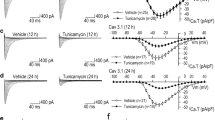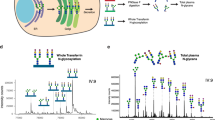Abstract
SCN5A gene encodes the voltage-gated sodium channel NaV1.5 which is composed of a pore-forming α subunit of the channel. Asparagine (N)-linked glycosylation is one of the common post-translational modifications in proteins. The aim of this study was to investigate impact of N-linked glycosylation disruption on the Na+ channel, and the mechanism by which glycosylation regulates the current density and gating properties of the Na+ channel. The NaV1.5-Na+ channel isoform (α submit) derived from human was stably expressed in human embryonic kidney (HEK)-293 cells (Nav1.5-HEK cell). We applied the whole-cell patch-clamp technique to study the impact of N-linked glycosylation disruption in Nav1.5-HEK cell. Inhibition of the N-glycosylation with tunicamycin caused a significant increase of NaV1.5 channel current (INa) when applied for 24 h. Tunicamycin shifted the steady-state inactivation curve to the hyperpolarization direction, whereas the activation curve was unaffected. Recovery from inactivation was prolonged, while the fast phase (τfast) and the slow phase (τslow) of the current decay was unaffected by tunicamycin. INa was unaffected by tunicamycin in the present of a proteasome inhibitor MG132 [N-[(phenylmethoxy)carbonyl]-l-leucy-N-[(1S)-1-formyl-3-methylbutyl]-l-leucinamide], while it was significantly increased by tunicamycin in the presence of a lysosome inhibitor butyl methacrylate (BMA). These findings suggest that N-glycosylation disruption rescues the NaV1.5 channel possibly through the alteration of ubiquitin–proteasome activity, and changes gating properties of the NaV1.5 channel by modulating glycan milieu of the channel protein.




Similar content being viewed by others
Abbreviations
- N-linked:
-
Asparagine-linked
- HEK cells:
-
Human embryonic kidney
- MG132:
-
N-[(phenylmethoxy)carbonyl]-l- leucy-N-[(1S)-1-formyl-3-methylbutyl]- l-leucinamide
- BMA:
-
Butyl methacrylate
- DMEM:
-
Dulbecco's modified Eagle's medium
- INa :
-
Voltage-gated sodium channel current
- LQT3:
-
Long QT syndrome type 3
- TEA-Cl:
-
Tetraethylammonium chloride
- TEA-OH:
-
Tetraethylammonium hydroxide
- HEPES:
-
4-(2-Hydroxyethyl)-1-piperazineethanesulfonic acid
- G:
-
Conductance
- I-V curve:
-
Current–voltage curve
- ER:
-
Endoplasmic reticulum
- FOXO1:
-
Forkhead box protein O1
References
Imaizumi S, Shiga Y, Ogawa M, Sako H, Nagata Y, Matsunaga A, Shirotani T, Hoshino F, Yahiro E, Uehara Y, Morito N, Tanigawa H, Shimono D, Fukushima M, Sugihara H, Norimatsu K, Kusumoto T, Saku K, Miura SI; ACADEMIE Study Investigators (2019) Randomized trial of an increased dose of calcium channel blocker or angiotensin II type 1 receptor blocker as an add-on intensive depressor therapy in type 2 diabetes mellitus patients with uncontrolled essential hypertension: the ACADEMIE Study. Heart Vessels 34:698–710
Tanaka Y, Hayashi K, Fujino N, Konno T, Tada H, Nakanishi C, Hodatsu A, Tsuda T, Nagata Y, Teramoto R, Yoshida S, Nomura A, Kawashiri MA, Yamagishi M (2019) Functional analysis of KCNH2 gene mutations of type 2 long QT syndrome in larval zebrafish using microscopy and electrocardiography. Heart Vessels 34:159–166
Chen XM, Guo K, Li H, Lu QF, Yang C, Yu Y, Hou JW, Fei YD, Sun J, Wang J, Li YX, Li YG (2019) A novel mutation KCNQ1p.Thr312del is responsible for long QT syndrome type 1. Heart Vessels 34:177–188
Wang Y, Liu L, Tao H, Wen L, Qin S (2020) TRPC6 participates in the development of blood pressure variability increase in sino-aortic denervated rats. Heart Vessels. https://doi.org/10.1007/s00380-020-01682-1
Li J, He Y, Bu H, Wang M, Yu J, Li L, Li H, Zhang X, Cui X, Cheng M (2020) Oscillating shear stress mediates mesenchymal transdifferentiation of EPCs by the Kir2.1 channel. Heart Vessels 35:1473–1482
Wu J, Zhou W, Wu L, Qian Y, Lu Y, Li F (2020) Ionic mechanisms underlying atrial electrical remodeling after a fontan-style operation in a canine model. Heart Vessels 35:731–741
Ruane-O’Hora T, Markos F (2020) Small and intermediate Ca2+-sensitive K+ channels do not play a role in vascular conductance during resting blood flow in the anaesthetised pig. Heart Vessels 35:284–289
Nakano Y, Shimizu W (2016) Genetics of long-QT syndrome. J Hum Genet 61:51–55
Hu D, Barajas-Martínez H, Pfeiffer R, Dezi F, Pfeiffer J, Buch T, Betzenhauser MJ, Belardinelli L, Kahlig KM, Rajamani S, DeAntonio HJ, Myerburg RJ, Ito H, Deshmukh P, Marieb M, Nam GB, Bhatia A, Hasdemir C, Haïssaguerre M, Veltmann C, Schimpf R, Borggrefe M, Viskin S, Antzelevitch C (2014) Mutations in SCN10A are responsible for a large fraction of cases of Brugada syndrome. J Am Coll Cardiol 64:66–79
Shan L, Makita N, Xing Y, Watanabe S, Futatani T, Ye F, Saito K, Ibuki K, Watanabe K, Hirono K, Uese K, Ichida F, Miyawaki T, Origasa H, Bowles NE, Towbin JA (2008) SCN5A variants in Japanese patients with left ventricular noncompaction and arrhythmia. Mol Genet Metab 93:468–474
Hesse M, Kondo CS, Clark RB, Su L, Allen FL, Geary-Joo CT, Kunnathu S, Severson DL, Nygren A, Giles WR, Cross JC (2007) Dilated cardiomyopathy is associated with reduced expression of the cardiac sodium channel Scn5a. Cardiovasc Res 75:498–509
Laurent G, Saal S, Amarouch MY, Béziau DM, Marsman RF, Faivre L, Barc J, Dina C, Bertaux G, Barthez O, Thauvin-Robinet C, Charron P, Fressart V, Maltret A, Villain E, Baron E, Mérot J, Turpault R, Coudière Y, Charpentier F, Schott JJ, Loussouarn G, Wilde AA, Wolf JE, Baró I, Kyndt F, Probst V (2012) Multifocal ectopic Purkinje-related premature contractions: a new SCN5A-related cardiac channelopathy. J Am Coll Cardiol 60:144–156
Baycin-Hizal D, Gottschalk A, Jacobson E, Mai S, Wolozny D, Zhang H, Krag SS, Betenbaugh MJ (2014) Physiologic and pathophysiologic consequences of altered sialylation and glycosylation on ion channel function. Biochem Biophys Res Commun 453:243–253
Scott H, Panin VM (2014) N-glycosylation in regulation of the nervous system. Adv Neurobiol 9:367–394
Mercier A, Clément R, Harnois T, Bourmeyster N, Bois P, Chatelier A (2015) Nav1.5 channels can reach the plasma membrane through distinct N-glycosylation states. Biochim Biophys Acta 1850:1215–1223
Kang L, Zheng MQ, Morishima M, Wang Y, Ono K (2009) Bepridil up-regulates cardiac Na+ channels as a long-term effect by blunting proteasome signals through inhibition of calmodulin activity. Br J Pharmacol 157:404–414
Liu Y, Wang P, Ma F, Zheng M, Liu G, Kume S, Kurokawa T, Ono K (2019) Asparagine-linked glycosylation modifies voltage-dependent gating properties of CaV3.1-T-type Ca 2+ channel. J Physiol Sci 69:335–343
Lazniewska J, Weiss N (2014) The “sweet” side of ion channels. Rev Physiol Biochem Pharmacol 167:67–114
Gong Q, Anderson CL, January CT, Zhou Z (2002) Role of glycosylation in cell surface expression and stability of HERG potassium channels. Am J Physiol Heart Circ Physiol 283:H77-84
Weiss N, Black SA, Bladen C, Chen L, Zamponi GW (2013) Surface expression and function of Cav3.2 T-type calcium channels are controlled by asparagine-linked glycosylation. Pflugers Arch 465:1159–1170
Gallastegui N, Groll M (2010) The 26S proteasome: assembly and function of a destructive machine. Trends Biocheml Sci 35:634–642
Verma R, Chen S, Feldman R, Schieltz D, Yates J, Dohmen J, Deshaies RJ (2000) Proteasomal proteomics: identification of nucleotide-sensitive proteasome-interacting proteins by mass spectrometric analysis of affinity-purified proteasomes. Mol Biol Cell 11:3425–3439
van Bemmelen MX, Rougier JS, Gavillet B, Apothéloz F, Daidié D, Tateyama M, Rivolta I, Thomas MA, Kass RS, Staub O, Abriel H (2004) Cardiac voltage-gated sodium channel Nav1.5 is regulated by Nedd4-2 mediated ubiquitination. Circ Res 95:284–291
Rotin D, Kumar S (2009) Physiological functions of the HECT family of ubiquitin ligases. Nat Rev Mol Cell Biol 10:398–409
Sossalla S, Kallmeyer B, Wagner S, Mazur M, Maurer U, Toischer K, Schmitto JD, Seipelt R, Schöndube FA, Hasenfuss G, Belardinelli L, Maier LS (2010) Altered Na+ currents in atrial fibrillation effects of ranolazine on arrhythmias and contractility in human atrial myocardium. J Am Coll Cardiol 55:2330–2342
Gaspo R, Bosch RF, Bou-Abboud E, Nattel S (1997) Tachycardia-induced changes in Na+ current in a chronic dog model of atrial fibrillation. Circ Res 81:1045–1052
Valdivia CR, Chu WW, Pu J, Foell JD, Haworth RA, Wolff MR, Kamp TJ, Makielski JC (2005) Increased late sodium current in myocytes from a canine heart failure model and from failing human heart. J Mol Cell Cardiol 38:475–483
Shang LL, Pfahnl AE, Sanyal S, Jiao Z, Allen J, Banach K, Fahrenbach J, Weiss D, Taylor WR, Zafari AM, Dudley SC Jr (2007) Human heart failure is associated with abnormal C-terminal splicing variants in the cardiac sodium channel. Circ Res 101:1146–1154
Remme CA, Bezzina CR (2010) Sodium channel (dys)function and cardiac arrhythmias. Cardiovasc Ther 28:287–294
Lau DH, Clausen C, Sosunov EA, Shlapakova IN, Anyukhovsky EP, Danilo P Jr, Rosen TS, Kelly C, Duffy HS, Szabolcs MJ, Chen M, Robinson RB, Lu J, Kumari S, Cohen IS, Rosen MR (2009) Epicardial border zone overexpression of skeletal muscle sodium channel SkM1 normalizes activation, preserves conduction, and suppresses ventricular arrhythmia: an in silico, in vivo, in vitro study. Circulation 119:19–27
Funding
This work was supported in part by JSPS KAKEN 25460292 (KO) from the Japan Society for the Promotion of Science, Tokyo.
Author information
Authors and Affiliations
Contributions
All authors gave their informed consent prior to their inclusion in the study. PW, MW, XZ and YL conceived and planned the experiments. PW, MW, and XZ conducted the experiments. KY, MG and, GL contributed to data analysis and interpretation. SK, TK and KO took the lead in writing the manuscript.
Corresponding author
Ethics declarations
Conflict of interest
The authors declare that they have no known competing financial interests or personal relationships that could have appeared to influence the work reported in this paper.
Ethics approval
The experiments conducted in this work were approved by approved in advance by the Ethics Review Committee for Animal Experimentation of Oita University School of Medicine, and in accordance with the Guide for the Care and Use of Laboratory Animals published by the U.S. National Institutes of Health (NIH Publication No. 85-23, revised 1996).
Additional information
Publisher's Note
Springer Nature remains neutral with regard to jurisdictional claims in published maps and institutional affiliations.
Rights and permissions
About this article
Cite this article
Wang, P., Zhu, X., Wei, M. et al. Disruption of asparagine-linked glycosylation to rescue and alter gating of the NaV1.5-Na+ channel. Heart Vessels 36, 589–596 (2021). https://doi.org/10.1007/s00380-020-01736-4
Received:
Accepted:
Published:
Issue Date:
DOI: https://doi.org/10.1007/s00380-020-01736-4




